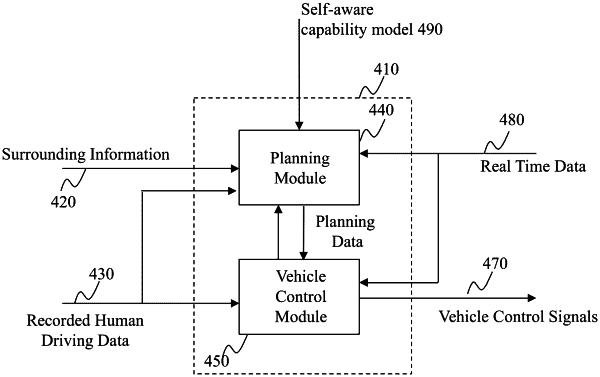| CPC B60W 40/09 (2013.01) [B60W 30/12 (2013.01); B60W 30/18163 (2013.01); G01C 21/3484 (2013.01); G01C 21/3602 (2013.01); G01C 21/3658 (2013.01); G05D 1/0088 (2013.01); G05D 1/0212 (2013.01); G05D 1/0246 (2013.01); B60W 2040/0872 (2013.01); B60W 2040/089 (2013.01)] | 20 Claims |

|
1. A computer-implemented method comprising:
based on sensor data, detecting, by a computing system, a lane that a vehicle is currently occupying;
receiving, by the computing system, data representing a presence of a passenger within the vehicle;
based on a dedicated set of training data for each model, separately training, by the computing device, a) a generic model for a general population and b) a plurality of personalized lane control models, relating to preferences of the passenger, associated with a plurality of driving environment scenarios, each personalized lane control model trained on training data that includes past human driving data relating to lane following and lane changing behavior related to the passenger associated with a corresponding driving environment scenario, the lane changing behavior related to the passenger associated with a corresponding driving environment scenario indicative of a) various speeds with which to lane change to a right lane, b) various speeds with which to lane change to a left lane, and c) various straight line or curved paths with which to lane change to a portion of a right lane or a left lane that is straight,
wherein the training data associated with the passenger is driving data of the passenger and grouped into training data groups, each training data group for training a personalized lane control model associated with a related driving environment scenario,
and wherein the personalized lane control model is further trained based on a personal profile of the passenger to allow the personalized lane control model to further reflect preferences of the passenger;
based on the data representing the presence of the passenger within the vehicle and a current driving environment scenario, selecting, by the computing system, a personalized lane control model related to preferences of the passenger associated with lane planning including lane following and lane changing;
generating, by the computing system, a lane control plan for the vehicle based on the lane that the vehicle is currently occupying and the personalized lane control model, wherein the lane control plan includes lane following and lane changing, and selection of lane following or lane changing is based on at least one of an explicit lane control decision provided by the passenger and an implied lane control decision to enter a lane to perform an action required in the lane;
generating, by the computing system, a signal to cause implementation of the lane control plan at the vehicle; and
in response to the signal, controlling, by the computing system, movement of the vehicle based at least in part on the lane control plan.
|